A translation of this article was made possible by a partnership with Planeteando. Una traducción de este artículo fue posible gracias a una asociación con Planeteando.
“Can you even imagine [that] ‘more water than on Earth’ is now possibly a common thing elsewhere in the solar system?” asked Steve Vance, a planetary scientist at NASA’s Jet Propulsion Laboratory and a project scientist for the agency’s Europa Clipper mission.
Earth might be the showiest blue marble, but Jupiter’s moons Europa and Ganymede, Saturn’s moons Enceladus and Titan, and more objects in the outer solar system have turned out to be remarkably active ocean worlds. Their surfaces show evidence of vibrant resurfacing on timescales shorter than we imagined. Their interiors are filled with exotic forms of ice and vast seas of water. They may have hydrothermal vents feeding into oceans. All of these characteristics add up to potential habitability.
The driver for much of this dynamism is volcanism. Deep in these moons’ interiors could lie the silicate volcanism so common on Earth, whereas a more exotic form of volcanism may churn their icy surfaces. The mix of heat, water, ice, and rock makes these worlds fascinating to planetary and Earth scientists alike.
Could these icy, volcanic moons host life? What does it take to create habitable zones in the outer solar system? Clues from these ocean worlds might upend how we search for habitable worlds and help inform how life might arise across the galaxy.
The Need to Keep Warm
All ocean worlds, including Earth, need one thing: heat.
On our planet, heat originates from two sources. The heat that keeps our oceans liquid mainly comes mainly from the Sun. Earth’s interior, on the other hand, is kept warm by radioactive decay of elements and residual heat from our planet’s formation. All that internal heat must go somewhere—“It is really hard for such a large object to get all of its radioactive heat out,” explained Vance—and volcanism is an efficient mechanism to make it happen.
In the outer solar system, something else is needed to generate the heat that allows for liquid water and volcanism. At such distances, the Sun doesn’t provide enough energy to keep water liquid, and whereas the moons of gas giants are sizable—some larger than Mercury—they are still too small to host the amount of radioactive decay or residual heat needed to fuel the sorts of volcanism familiar on Earth.
Much of the heat found inside these ocean worlds comes from tidal forces. As it zips around a gas giant in concert with other moons, the ocean moon itself is stretched and distorted on a regular basis. Some of this energy is converted to heat.
We see this most dramatically on the innermost of Jupiter’s four Galilean moons, Io. Its orbit around Jupiter and its interactions with Callisto, Europa, and Ganymede mean that Io is tormented to the point that it is the most volcanically active body in the solar system.
Tidal effects on Jupiter’s other moons are less dramatic but still strong enough to sometimes allow for liquid water oceans beneath thick, icy shells. In the case of Europa, the tidal heating might even be sufficient for magma to form in its rocky mantle.
We don’t have direct evidence for silicate volcanism on any of these moons other than Io, but models indicate that their interiors could contain sufficient heat to cause rock to melt.
“What remains to be seen is how much…thermal and dynamic linkage there is between silicate volcanism in the interior and what happens above it,” explained Sarah Fagents, a planetary volcanologist at the University of Hawai‘i at Mānoa.
Cryovolcanism
These moons may actually be the source of not one but two types of volcanism: silicate volcanism and its distant cousin, cryovolcanism.
Cryovolcanism describes the process in which a volcano erupts volatiles such as ammonia (as opposed to silicates such as feldspar) into an environment below the volatiles’ freezing point. In the outer solar system, the surfaces of most objects are so cold that water is always frozen. This is part of why images of potential cryovolcanism from NASA’s Voyager, Galileo, and Cassini missions were so startling to scientists.
The plumes of Enceladus are almost certainly examples of cryovolcanism, which may have contributed to such features as the ridges of Europa and the mountains of Titan.
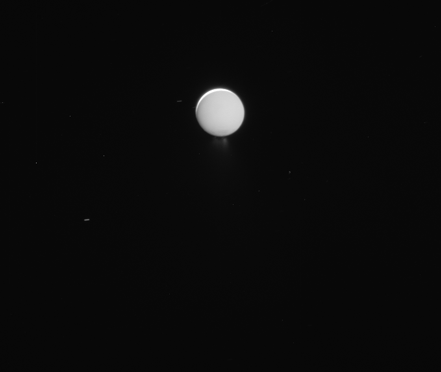
Fagents was studying earthly “basaltic lavas and explosive things,” she remembered, when “my boss pulled me into looking at surface features on Europa. It was astonishing. You look at the surface of Europa and it’s covered in such a diversity of features…. [T]here are these little dome-like and flow-like features that really look to me like fluids were on the surface.”
To Fagents and other volcanologists, the dome-like and flow-like features of Europa brought to mind the familiar lava domes and flows in places like the Cascades or Yellowstone in North America. Yet the surface of Europa is made entirely of ice, and according to the geophysical data we currently have, no rocks exist for hundreds of kilometers below its icy carapace.
“There are features on the surfaces of these bodies that we don’t have a good terrestrial analogue for,” Fagents explained. “We try to make…silicate volcanic analogues, but I don’t think those are necessarily the best.”
This alternative to silicate volcanism opens the door between disciplines. “There is a lot we can learn from the fields of glaciology and hydrology that might be more pertinent than volcanology,” Fagents said. “You need to bring in a diversity of expertise and viewpoints” to better understand the phenomenon.
Fracturing Theories
“I found a link between planetary science and my physics background in thinking about geophysical fluid dynamics on Europa.”
Lynnae Quick, a planetary geophysicist at NASA Goddard Space Flight Center and a mission scientist on Europa Clipper, was one of those people whose expertise helped bridge scientific observation with scientific process. “While I was in graduate school studying physics, [planetary scientist] Louise Prockter offered me an internship at APL [Johns Hopkins University Applied Physics Laboratory], so I spent a summer studying Europa,” recalled Quick. “I really fell in love with it. I found a link between planetary science and my physics background in thinking about geophysical fluid dynamics on Europa.”
Quick was intrigued by the mechanisms of cryovolcanism because, at least compared with terrestrial volcanism, the phenomenon can appear counterintuitive. Silicate magma tends to be less dense and more buoyant than the rock around it, causing it to rise and erupt. Liquid water, on the other hand, is denser than its solid counterpart. (Anyone who has observed the ice in a drink has seen this contradiction in action: Ice floats.) So the idea that liquid water in the icy shell of Europa could rise and erupt above ice was challenging to imagine.
“Volcanism is a purely endogenic process driven by melting and buoyant rise…but cryovolcanism is a little trickier than that,” said Fagents. There must be fractures in the icy shell and then a mechanism to get liquid to flow through those fractures. “The density difference isn’t great, but it certainly would want to keep ocean water where it is, especially if it is briny and denser than regular water.”
Two main theories have emerged for how liquid water (cryomagma) can erupt, and in both, tidal forces again come into play. The first theory involves the tidal stretching and squeezing that ocean worlds experience as they orbit their home planet. These tidal processes may cause pockets of water to pressurize during certain parts of the moon’s orbit, and potentially trigger eruptions.
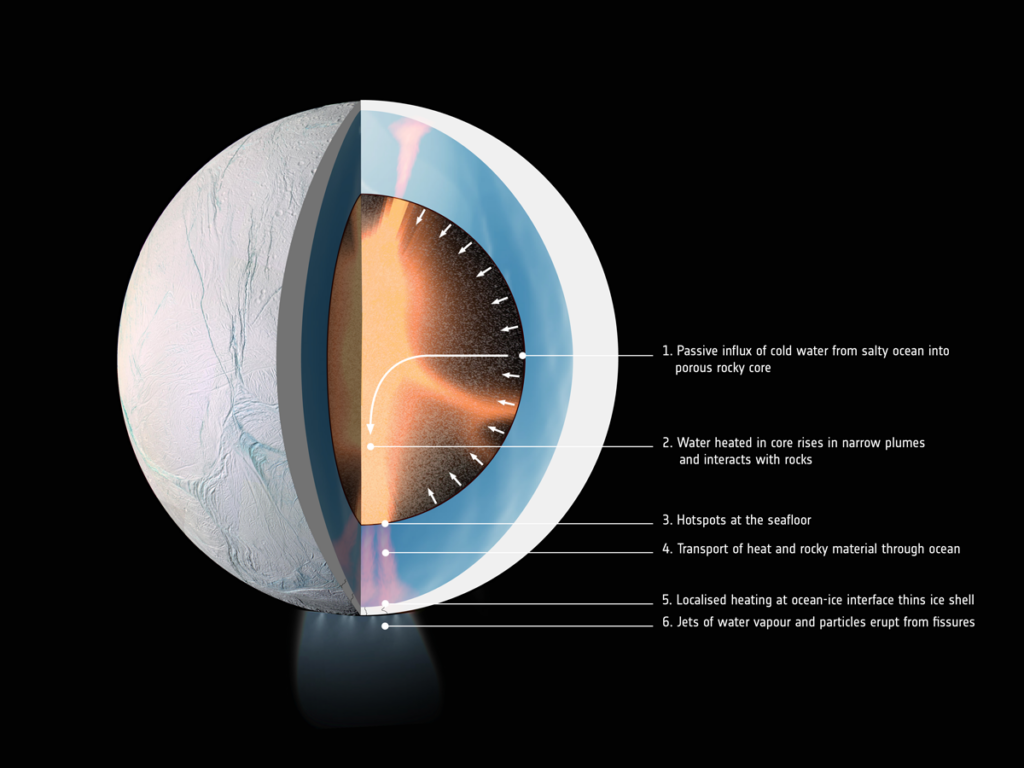
The second theory, proposed by Fagents in 2003 and developed further by Elodie Lesage of the Jet Propulsion Laboratory, considers water’s transition to a solid and the accompanying increase in volume, which can be a powerful force. On Earth, for instance, it can destroy mountains with frost wedging. On an ocean world like Europa, where pockets of liquid water might reside in the icy shell, increasing ice volume would raise the pressure in such pockets.
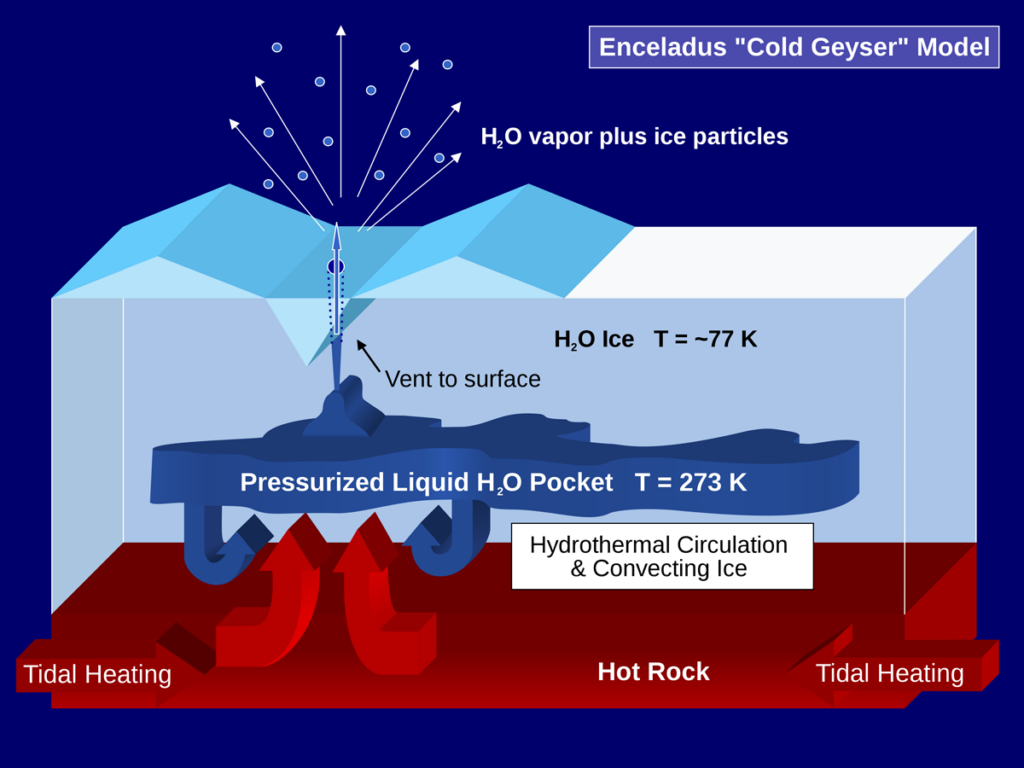
“You have pockets of melt in the crust, and they have excess pressure acting on them,” explained Quick. “We’re assuming that these pockets are not necessarily going to deform within brittle ice to accommodate the excess pressure. The only way to relieve the pressure is to have fluid-filled fractures that are created by the pressurization of these pockets to rise to the surface.”
“It’s surprising how many feature types we see that could potentially be cryovolcanic,” said Fagents. “We haven’t really got a smoking gun except for Enceladus.”
More Questions Than Answers
Right now, Fagents said, scientists are left with more questions than solutions.
“We know that pieces of the puzzle work in isolation,” she said, but “we don’t know how the puzzle pieces go together and whether they really do go together in terms of understanding volcanism from depth to the surface.”
Some of those puzzle pieces include how fractures in the ice are kept open to allow for eruptions to occur. “One of the sticking points is the fact that it’s so hard to get throughgoing fractures in the ice shell, especially for the thicknesses of ice shells we’re looking at,” explained Fagents. “Clearly Enceladus manages it, but with thicker ice shells, you have static pressure wanting to close any fractures that open up.”
Another problem is the mechanism by which planetary features with liquid water or icy slurries are made. “Liquid water has a very low viscosity,” she added. “You can’t make relief with water.”
Yet another puzzling characteristic of the moons is the age of their icy surface features. Data have revealed that the surfaces of these ocean worlds are much younger than scientists anticipated when Voyager 1 and 2 first headed to the outer solar system.
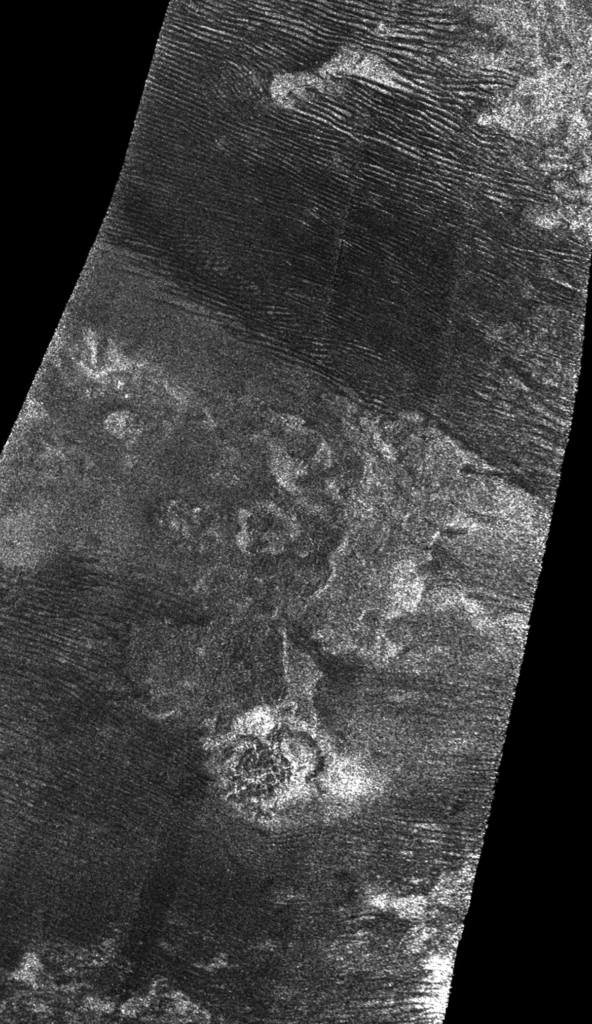
“On Europa, we know that the liquid in the subsurface has salts and minerals and all these wonderful things,” explained Quick as she described how to interpret the surfaces of icy moons. “If we see a feature that is low albedo—that’s a relatively dark surface—we know it’s pretty fresh, it’s pretty young.”
Quick pointed out that on Titan, Cassini-Huygens imaged what may be an ammonia-rich fluid coming out of the Doom Mons volcano. This flow was likely solid at the time, she said, but still hinted at recent cryovolcanism.
Things could be even weirder. Vance thought there could be “brine volcanism” driven by denser, salt-rich fluids on worlds with thick icy shells above a liquid ocean. “It’s inverted volcanism,” he explained, and not entirely unfamiliar on Earth. Such phenomena are “short lived in Antarctica, but that’s because [the] volumes of material [the brines] can flow through are small. It is intriguing to imagine, in a 30-kilometer ice shell on Europa, some means for accumulating lots of brines—strong chemical gradients, especially if, in the case of Europa, you have oxygen-rich ice flowing into relatively reducing ocean.”
Ice, Volcanoes, and Life
All this theorizing hinted at the most captivating question of all: Could there be life? Answering that question requires us to understand how the rock, water, and ice components of these ocean worlds connect.
“If you think about moons like Europa and Enceladus, where there are oceans that sit right on top of rocky mantles, that means they have a seafloor,” said Quick. “If that rocky material is warm in any way, we expect there to be hydrothermal vents and the type of chemistry that we see at the Earth’s seafloor.”
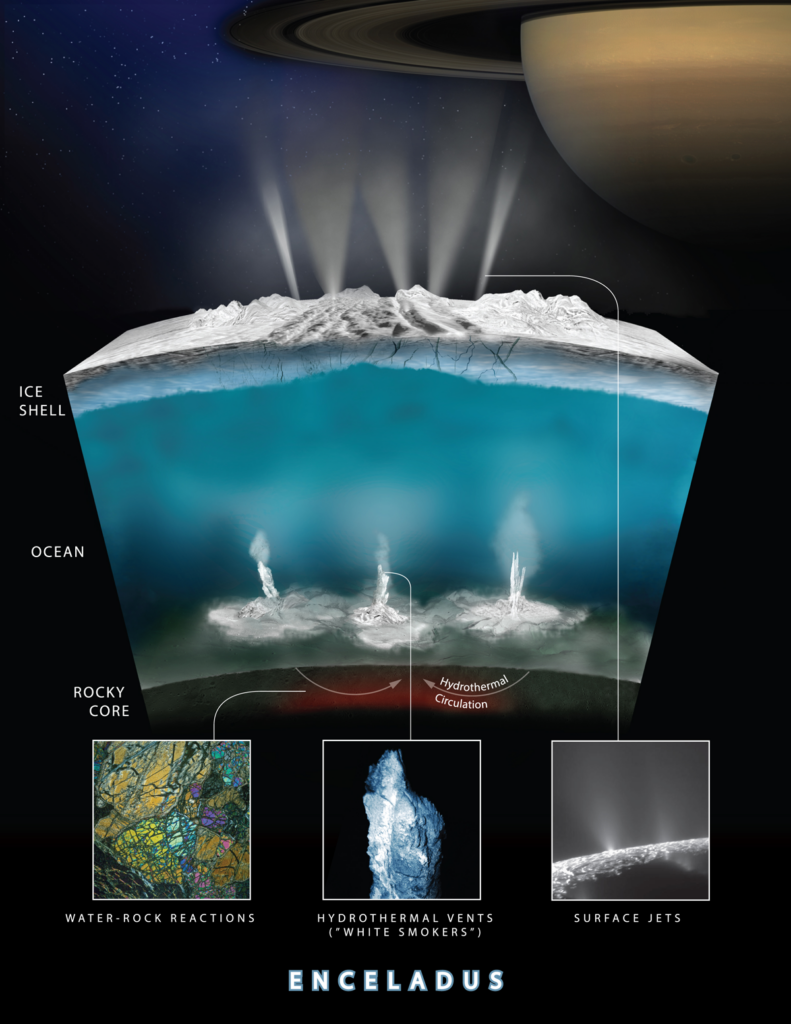
That is the next frontier.
“We know that for life, we need a source of energy. We need liquid water. We need organics,” said Quick. “For places like Europa and Enceladus, we’ve detected organics, we know we have liquid water, and we have tidal heating.”
So the pieces may be in place for life, or at least for habitability, in the outer solar system. The question of whether life could emerge on ocean worlds like Enceladus, Europa, or Titan comes down to where those different components meet.
In the outer solar system, “the open ocean and mid-depths don’t have a lot going on because that’s not where the primary strong gradients of energy are located,” said Vance. More promising locations may be found where chemical and energy gradients occur, driving chemical reactions. On ocean worlds, these interfaces include areas between rocky interiors and oceans, or even the boundary between oceans and icy shells.
Jennifer Glass, an associate professor in the School of Earth and Atmospheric Sciences at Georgia Institute of Technology, approached the question of habitability and life outside Earth from a different angle.
“The main way you can build up biomass,” she explained, “is respiration, that is, having a source of electrons (a reductant) and then a sink for those electrons (an oxidant) and then moving the electrons along a membrane and pumping protons.”
This respiration process may have occurred on early Earth at hydrothermal vents, with volcanism and magmatism making it possible. Tidal heating may play that role on ocean worlds like Enceladus, Europa, and Titan. Without it or another “source of internal heat of some form, this is all off the table,” said Glass. “You need heat and a source of reduced compounds…. Environments like vents would also be advantageous because you get strong gradients.”
Glass thinks that after Earth, ocean worlds likely harbor the most habitable conditions in our solar system. But then it gets complicated. “We are really thinking of a system that is just an island in the deep,” Glass said of hydrothermal vents, “but it’s still very much reliant on oxidants from the surface.”
An influential study by Eric Gaidos of the University of Hawai‘i at Mānoa and his colleagues described how challenging it would be for life to gain a foothold on an icy ocean world. “Even if Europa’s interior is geologically active, energy-generated reactions such as methanogenesis and sulfur reduction used by terrestrial organisms would not be available to hypothetical life-forms,” Gaidos and his coauthors wrote. “[C]arbon and sulfur will be outgassed as reduced rather than oxidized species.”
“Cryovolcanism really kind of stirs the pot to make it so that the energy and organics are cycled through the shallow subsurface.”
Hypothetical life-forms might instead depend on manna from above. “Look at water, energy, organics,” said Quick. “Cryovolcanism really kind of stirs the pot to make it so that the energy and organics are cycled through the shallow subsurface.”
“What makes cryovolcanism important [for potential life on ocean worlds], in a way that’s distinct from silicate volcanism, is [that] it’s what keeps normally cold moons warm and could provide places for life within their ice shells,” Quick said. “We have cryomagmas moving through the ice shell, so then you have warm, slushy, salty pockets of water.”
Fagents agreed. “Moving fluids through an ice shell would be really important as well, because [the process brings] nutrients into contact with habitable environments,” she said.
Those pockets of water might even be a habitat unto themselves. “There are bacteria in gas clathrates” on Earth, explained Glass. “You could think of them as almost an ice niche. If you have any melted pockets of water [on an ocean world], that could be habitable for them.”
Diving into the Outer Solar System and Beyond
“These worlds have really changed our thinking about what makes a habitable world and where that has to be around the star,” said Quick.
Habitable worlds can circle large planets and generate heat needed for volcanism—and liquid water.
Data from the James Webb Space Telescope are enriching astronomers’ knowledge of exoplanets every day, and a veritable flotilla of missions will head to the outer solar system over the next decade. NASA’s Europa Clipper will orbit Europa, Dragonfly will visit the surface of Titan, and the European Space Agency’s JUICE (Jupiter Icy Moons Explorer) will make observations in unprecedented detail of Callisto, Europa, and Ganymede.
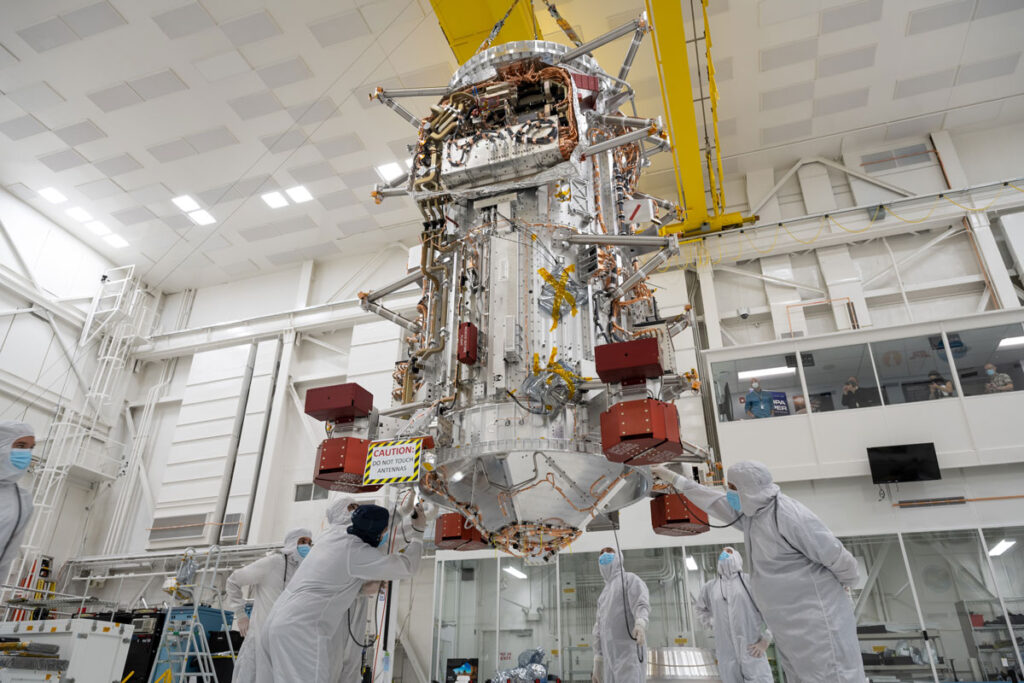
Scientists look forward to comparing new data with those collected by earlier missions. “If Europa Clipper sees surface features that were characterized as potential cryolava flows or plume deposits when first imaged by the Galileo spacecraft, and those features have since become larger or are still very low albedo, then this might suggest that cryovolcanism has been a regular occurrence and that eruptions have been occurring, at least sporadically, since the feature was first imaged,” explained Quick.
Exploring the ice and volcanoes of the outer solar system will also help scientists learn about our own planet and its origins. “When we think about destinations like Saturn’s moon Titan,” Quick said, “it’s kind of like we’re able to look…back in time on Earth. And it’s wonderful that we have the capabilities to do that.”
—Erik Klemetti (@eruptionsblog), Science Writer



